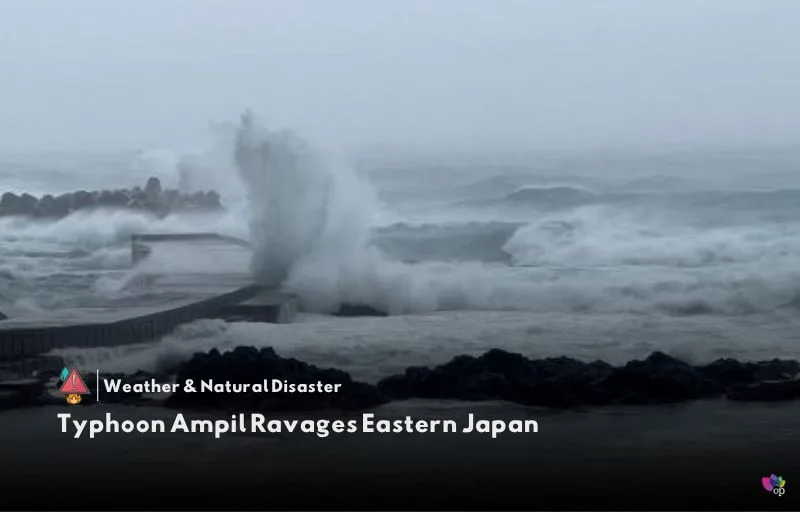Overview
Typhoon Ampil unleashed its fury on eastern Japan, bringing powerful winds and heavy rains that wreaked havoc across the region. By August 16, the typhoon had intensified into a formidable storm with maximum sustained winds of 132 miles per hour, resembling the intensity of a Category 4 hurricane. The typhoon’s impact was severe, leading to widespread flooding, significant transportation disruptions, and mandatory evacuations in high-risk areas.
Storm Impact and Immediate Effects
The initial signs of Typhoon Ampil’s impact were evident early on August 16, as rain began to fall steadily over the greater Tokyo area. The storm’s force was demonstrated in Chiba Prefecture, where streets were inundated and trees were uprooted. Local authorities promptly issued evacuation orders for regions susceptible to landslides and flooding. In Mobara, a city located east of Tokyo, preventive measures were implemented to safeguard residents in vulnerable areas.
The Japan Meteorological Agency issued warnings for heavy rainfall, strong winds, and high waves, covering a broad area from the Izu Islands to several prefectures, including Chiba, Fukushima, and Shizuoka. These warnings highlighted the serious threat posed by Ampil, as it continued to intensify, causing severe damage to coastal areas and increasing the risk of landslides in mountainous regions.
Disruptions to Infrastructure and Services
The typhoon’s impact extended beyond physical damage to significant disruptions in business and transportation sectors. Major delivery services, including Japan Post and Yamato Transport, were compelled to halt operations in the affected prefectures, leading to disruptions in logistics and supply chains. Sagawa Express also faced delays due to road closures and cancellations of ferry and flight services. These interruptions affected multiple regions, including Hokkaido, Japan’s northernmost island.
The travel industry experienced severe disruptions as early as August 15, when airlines and train operators preemptively suspended services. Both All Nippon Airways (ANA) and Japan Airlines (JAL) canceled over 670 domestic flights scheduled for August 16 and 17, leaving more than 120,000 passengers stranded. The Shinkansen, or bullet trains, known for their punctuality, also suffered significant interruptions, with services between Tokyo and Nagoya coming to a halt.
Long-Term Risks and Challenges
Beyond immediate disruptions, Typhoon Ampil posed long-term risks, particularly concerning the potential for exacerbating natural disasters like landslides. Japan’s mountainous terrain and densely populated coastal areas make it especially vulnerable to such events when severe storms occur. The heavy rainfall and powerful winds from Ampil created conditions conducive to landslides, highlighting the region’s ongoing risks associated with typhoons.
The Japanese government’s proactive measures, including evacuation orders and early warnings, aimed to mitigate casualties and protect public safety. Despite these efforts, the risk remains high, particularly in rural or isolated areas with limited infrastructure. The ongoing recovery from the storm will require substantial efforts to address both immediate damage and long-term impacts.
Preparedness and Response
Typhoon Ampil underscores the challenges Japan faces in typhoon preparedness and response. While Japan is experienced in dealing with typhoons, the increasing intensity and frequency of these storms due to climate change pose new threats. The country has invested heavily in disaster preparedness infrastructure, including sea walls, drainage systems, and early warning networks. However, the sheer power of Ampil demonstrates that even with extensive preparations, severe storms can still cause significant disruptions and damage.
The storm’s impact on transportation networks, particularly the suspension of bullet trains and cancellation of flights, highlights the need for more resilient infrastructure. As Japan aims to boost its tourism industry, the vulnerability of its transportation systems to extreme weather poses a significant challenge. Addressing this issue will require improved weather forecasting and early warnings and the development of infrastructure that can withstand increasingly powerful storms.
Conclusion
Typhoon Ampil has once again showcased nature’s immense power and unpredictability, inflicting widespread damage and causing substantial disruptions to daily life in Japan. While the country’s advanced preparedness systems have helped mitigate the storm’s effects, the challenges posed by climate change are evident. Continued investment in resilient infrastructure, enhanced early warning systems, and refined disaster response strategies will be crucial for Japan as it navigates an increasingly volatile weather future.
References


 العربية
العربية 简体中文
简体中文 Français
Français Deutsch
Deutsch עִבְרִית
עִבְרִית हिन्दी
हिन्दी Italiano
Italiano 日本語
日本語 Русский
Русский Español
Español

Comments 2